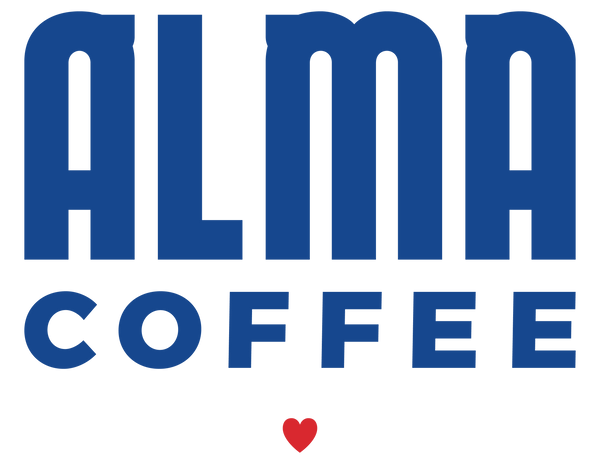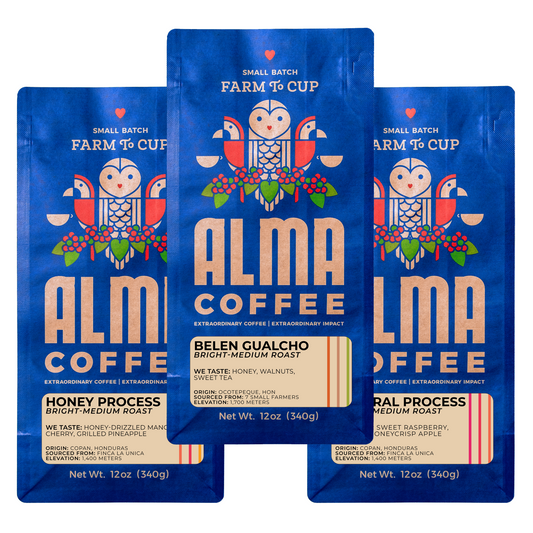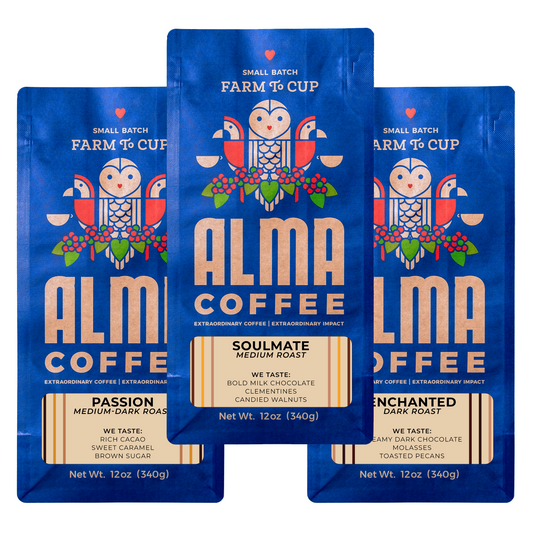
The Great Coffee Waves: What are the First, Second, and Third Coffee Waves? 🌊
Share
Coffee has seen an increase in consumer demand of epic proportion over the last 50 years.
If you remember when Nescafé was the hit new coffee trend, then you may already know what we’re talking about; but, those born and raised in the era of Starbucks might not be aware of just how sudden the shift to “coffee culture” has been, especially in recent decades.
This week’s blog post will give you a brief overview of the three major “waves” of coffee, what they represent in the evolution of coffee culture, and what we should expect in the “fourth wave” (if we haven’t already crossed that threshold).
So, grab a cup of coffee and sit back: we’re going to try our best to give you a crash course history lesson on the major moments of coffee history, or "waves," in 1200 words or less!
Blog Contents:
What are the "Waves" of COffee? 🌊☕️
Just like the “waves” of the industrial revolution or the “waves” of feminism, history buffs refer to major moments of transformation in the history of coffee culture as “waves.”
However, unlike feminism or industrial theory, the waves of coffee are focused specifically on how consumers interact with or relate to coffee as a consumable good, and that has changed significantly & swiftly with other historical and cultural trends around the world.
In a simple sense, the three waves of coffee represent how accessible or appreciated coffee was at certain points in time: the first wave represents the shift from novelty to commodity, the second wave represents a shift from commodity to culture, and the third wave represents a shift from culture to consumer awareness.
Of course, like anything in life, it is much more complicated than that. Keep reading to learn more about how the global consumer went from instant coffee to sustainably sourced, direct-trade coffee!
🌊1️⃣: From novelty to commodity
We’ve hinted in other blog posts about the origin of roasted coffee as a consumable good being in or around the 15th century, and this time stamp is universally accepted by coffee enthusiasts around the world.
But the leap from coffee's genesis to the ubiquity of Mr. Coffee drip machines is a steep one.
The first “wave” of coffee coincides with the first “wave” of the industrial revolution, which is defined by a global increase in mass-produced consumable goods—a few articles we’ve come across give a time range from the late 1800’s to 1920, but we won’t jump in on the debate this time around (See Oksnevad or Rothgeb).
We think that the best way to define the first wave of coffee is the shift from novelty to commodity. Before this moment, access to coffee in virtually any form was a privilege of the elite. The average person, aside from the coffee farmers who picked the beans, would have had almost no access to the benefits of our favorite bean prior to the manufacturing wonders of the industrial revolution.
That being said, this shift into widespread consumer affordability and accessibility didn’t happen overnight: companies like Folgers and Maxwell House made cheap, widely available coffee a grocery store staple by the mid 1950s. The idea of tasting notes, country of origin, washing process, or even understanding of the supply chain and how that influenced taste were wholly separated from the grocery shelves consumers were browsing.
Image courtesy of svipsx.com
This first “wave” was probably the longest of the four we’ll discuss today, mainly because the boundaries of where it begins and ends are still debated by coffee historians. But, we would mark the end of this wave by widespread accessibility to affordable coffee, likely between the 1950s and 1970s.
That being said, the rise of coffee as a commodity gradually sets us up for the second splash of coffee history...
🌊2️⃣: From COMMOdity to culture
Eventually, and for good reasons, coffee consumers started asking questions about what exactly was in their cup.
Sure, mass-produced coffee made it easy and affordable for the average person to stay caffeinated, but it also prioritized quantity over quality. The second wave of coffee signifies a shift in the expectations of consumers: although coffee had secured itself as a staple of consumer culture, a demand for higher quality & better tasting beans spiked by the 1990s.
TV shows like “Friends” and “Seinfeld” perfectly capture this transitionary period in coffee history: As cafés started popping up and becoming popular in metropolitan areas, new coffee companies like Starbucks saw an opportunity to capitalize on an emerging demand for a larger "speciality" market.
This was also a time where coffee shop popularity coincided with what some academics call the theoretical “third place,” or, in other words, a physical space that invited casual socialization with others in an escape from the office/home environment. Coffee shops seemed to open a new door for casual socialization that bars had been filling for centuries (See Parker).
If you watch(ed) sitcoms like Friends of Seinfeld, or if you plan to watch an episode or two after reading this, then you can clearly see how this theoretical “third place” became a popular cultural phenomenon amongst coffee consumers.
This wave also expanded the palate and expectations of consumers, too.
Rather than dousing black coffee in cream and sugar, the second wave of coffee introduced the larger market to steamed milk and espresso—cappuccinos, lattes, café au laits, and other staple café drinks were made more widely available by companies like Starbucks and perfected, specialized, or refined by local cafés and the talented baristas that staffed them.
🌊3️⃣: From CULTURE TO CONSUMER AWARENESS
This rift in coffee’s second wave between large companies and local artisans continued to widen as consumers switched their store-bought coffee for to-go lattes.
It wasn’t until the early-to-late 2000s that the “big guy” vs. “little guy” split in the coffee culture started forcing consumers to reflect on where, and not exactly how, their coffee was made.
Consumers in the third wave began to value the intricacies of coffee’s many origins and flavors, similar to how a wine connoisseur values their favorite fermented grapes. Even at the normal consumer level coffee brewing instruments for at-home use (like home grinders or espresso machines) started becoming affordable options for staying caffeinated.
This transition to at-home specialty coffee is a clear marker for the beginning of the third coffee wave, as consumer trends boosted the supply and demand of a specialty coffee market.
Coffee roasters and professional baristas also began seeing increased appreciation (and consumer funding) for their hard work.
Although huge coffee companies like Starbucks popularized the cozy and casual aspect of coffee cafes, the variability of brew time, roast profile, and grind setting started becoming common reference points for a new and growing segment of the coffee market—the "speciality" coffee consumer.
Additionally, The actual sourcing of “green bean,” the pre-roasted form of coffee, also saw wider recognition and appreciation amongst consumers at large. Unlike consumers within the first or maybe even the second wave, the actual supply chain (and the mistreatment of farm workers by large coffee producers) became top-of-mind for those interested in higher quality, more sustainably sourced coffee.
Organizations like the Specialty Coffee Association (SCA) have been a huge boost behind-the-scenes for increasing awareness and demand for specialty coffee at the consumer and industry levels, introducing the public to concepts such as "Direct-Trade."
However, we really need to thank the coffee shops, baristas, and local roasters who brought direct-trade, sustainably sourced coffee to the forefront of the industry. Without them, direct-trade roasters like us wouldn't be able to further the farm-to-cup mission!
4️⃣ The FOURTH wave: THE FINAL COFFEE FRONTIER?
And so, this brings us to the newest buzzword of the coffee industry: the “fourth wave.”
Although the transitions between each of the first three waves of coffee is clear in retrospect, they may not have been in the moment, especially if you consider all of the combined factors we've discussed in this blog that mark a coffee "wave." However, even if it takes decades, we expect the trend towards higher quality & more ethically sourced coffee to continue far into the future and, eventually, become a majority of the coffee consumer market (if it hasn’t already)
Does that mean we are in the fourth wave now?
We’ll leave that decision for the coffee historians to decide (like Trish Rothgeb, for instance). For now, we hope that this blog illuminated the history, definition, and impact of each of the first three waves of coffee, including the huge transformation coffee has undertaken in consumer culture in such a short amount of time.
As lovers of coffee in all forms here at Alma, we geek out anytime we get to take a deep dive into the history of our favorite caffeinated beverage. Until our next blog, be sure to leave a comment below and let us know what you remember from the three waves, or what you look forward to in the fourth wave.
Sources:
- Oksnevad, Dan. “The Differences Between 1st, 2nd, and 3rd Wave Coffee.” Driven Coffee, 24 Apr. 2020, www.drivencoffee.com/blog/coffee-waves-explained/.
- Ott, Brian. "Minimum-wage Connoisseurship and Everyday Boundary Maintenance: Brewing Inequality in Third Wave Coffee." Humanity & Society 44.4 (2020): 469-491.
- Packer, Randall. "Third space network: Theatrical roots." Lumina 11.2 (2017): 82-109.
- Rothgeb, Trish. “Norway and Coffee.” The Roaster's Guild, web.archive.org/web/20031011091223/roastersguild.org/052003_norway.shtml.
Written by: Kelley Bostian






39 comments
I just want the whole world to know about this spell caster I met two weeks ago,I cannot say everything he has done for me and my family I was going through online when I meant this wonderful man’s testimony online how he won a lottery through the help of dr Ose I decided to just give it a try and my life is back to me now after i lost my job due to covid he gave me a winning numbers to play lottery and i won 5000usd for my first play since then i have been working with him and he has been giving me numbers to play my lottery i can not write everything he has done for me if you need a lottery spell today contact him on oseremenspelltemple@gmail.com www.facebook.com/Dr-odion-spell-temple-110513923938220
whatsapp +2348136482342
BE SMART AND BECOME RICH IN LESS THAN 3DAYS….It all depends on how fast
you can be to get the new PROGRAMMED blank ATM card that is capable of
hacking into any ATM machine,anywhere in the world. I got to know about
this BLANK ATM CARD when I was searching for job online about a month
ago..It has really changed my life for good and now I can say I’m rich and
I can never be poor again. The least money I get in a day with it is about
$50,000.(fifty thousand USD) Every now and then I keeping pumping money
into my account. Though is illegal,there is no risk of being caught
,because it has been programmed in such a way that it is not traceable,it
also has a technique that makes it impossible for the CCTVs to detect
you..For details on how to get yours today, email the hackers on : (
atmmachinehackers1@gmail.com < Tell your
loved once too, and start to live large. That’s the simple testimony of how
my life changed for good…Love you all .
I just want the whole world to know about this spell caster I met two weeks ago,I cannot say everything he has done for me and my family I was going through online when I meant this wonderful man’s testimony online how he won a lottery through the help of dr Ose I decided to just give it a try and my life is back to me now after i lost my job due to covid he gave me a winning numbers to play lottery and i won 5000usd for my first play since then i have been working with him and he has been giving me numbers to play my lottery i can not write everything he has done for me if you need a lottery spell today contact him on oseremenspelltemple@gmail.com www.facebook.com/Dr-odion-spell-temple-110513923938220
whatsapp +2348136482342
I am Gavin Sparks, a Sweden born programmer living in Phoenix. After mining 100 btc worth $2.6M early 2021, I decided to sell off my old laptop and had to save all the wallets’ private keys and passwords to a small hard drive known as Iron keys. Unluckily the drive got lost. I tried several times to enter the password with no luck. I had to look for a hacker’s help to revive my wallet. That’s when I came across Recovery Masters, modernized experts in crypto Recovery. After a serious conversation with them my wallet was retrieved back with all my funds intact. I Must recommend them for the good and reliable services.
Contact LostRecoveryMasters:
Web site ( https://lostrecoverymasters.com )
Email ( Support@lostrecoverymasters.com )
Whatsapp (+44(7537)-105921)
I am Gavin Sparks, a Sweden born programmer living in Phoenix. After mining 100 btc worth $2.6M early 2021, I decided to sell off my old laptop and had to save all the wallets’ private keys and passwords to a small hard drive known as Iron keys. Unluckily the drive got lost. I tried several times to enter the password with no luck. I had to look for a hacker’s help to revive my wallet. That’s when I came across Recovery Masters, modernized experts in crypto Recovery. After a serious conversation with them my wallet was retrieved back with all my funds intact. I Must recommend them for the good and reliable services.
Contact LostRecoveryMasters:
Web site ( https://lostrecoverymasters.com )
Email ( Support@lostrecoverymasters.com )
Whatsapp (+44(7537)-105921)